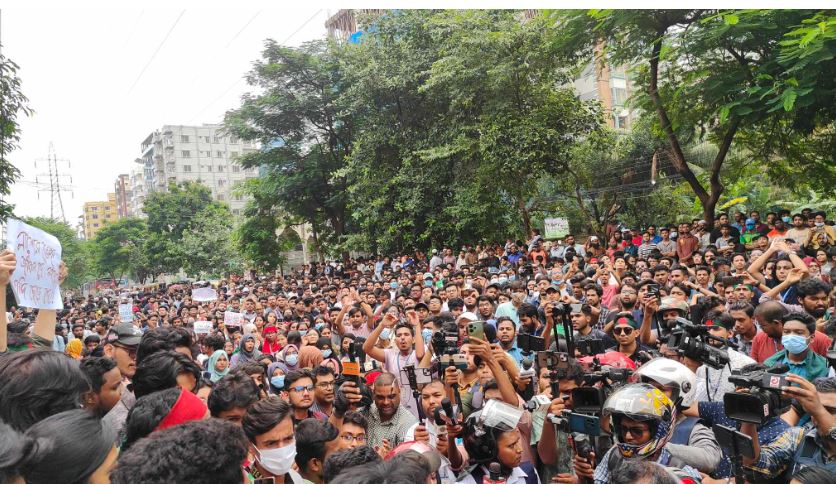
The factors that induced and precipitated the political turmoil that Bangladesh has witnessed leading the leader of the Awami League party Sheikh Hasina to flee the country and subsequent killings of more than 400 people and efforts by the protesters to sabotage the statue of Sheikh Mujibur Rahman who played a pivotal role in the country’s freedom struggle and attempts to set houses and temples of Hindus at fire are not still very clear.
The students agitation began in June this year in a form of peaceful protest when the High Court of Bangladesh reinstated the reservation system by reversing the government order of 2018 which already had scrapped the controversial quota system that reserved 30 percent of jobs for families of veterans who fought in the 1971 Liberation War. On July 21, the Supreme Court of Bangladesh struck down the June ruling by the High Court and significantly reduced quota for freedom fighters’ descendants by limiting it to mere 5 percent. In spite of this substantive reductions in the controversial reservation system and the fact that it was the High Court not the Hasina government which reinstated the reservation for the family members of war veterans, the protest rather turned more violent bent on a regime change. The sudden surge in violence blowing out of proportions in the small South Asian country on an issue where the government did not have a direct role leads to a conspiracy theory that the entire episode of violence might have been propped up by external actors.
Nonetheless, there were growing anti-regime undercurrents as the Bangladesh National Party (BNP), the main political opposition of Awami League boycotted the general elections of this year alleging that democracy has been sabotaged in the country through practices such as electoral fraud, intimidation and widespread rigging whereas the Awami League and its allies won 225 of 300 parliamentary seats formed the government. Indicating an increase in the anti-democratic tide in the country, Human Rights Watch (HRW) reported that nearly 10,000 activists were arrested after an opposition rally turned violent on 28 October last year, resulting in the deaths of at least 16 people and injuring more than 5,500.The US has also placed sanctions on the elite Rapid Action Battalion of Bangladesh over disappearances and extrajudicial killings. These feelings of political alienation and persecution among the opposition along with putative external support and indoctrination might have influenced the protest to take this shape. Meanwhile, an interim government headed by Nobel laureate Muhammad Yunus will lead the country from this turmoil.
However, the small South Asian country which was known as one of the poorest countries in the South Asian region demonstrated remarkable economic growth under the leadership of Hasina since 2009 when she came to power and remained at the helm until the recent political upheaval. The South Asian country came to be acknowledged as one of the fastest-growing economies in the region by lifting 25 million people out of poverty in the last 20 years showing better economic indicators than those of India. For instance, its GDP per capita has exceeded that of India’s since 2018 even while the country’s economy has been in recovery mode since the Covid-19 pandemic.
India Remains Uncomfortable
Bangladesh is located on the cusp of South and Southeast Asia and figures prominently in India’s eastward march. Thus, success of India’s act east policy would largely hinge on the country’s forging of successful ties with Bangladesh.
The small South Asian country is bound by India to the north, east and west that makes it better connected to India in terms of rail, road, waterways, sea and air compared to any other neighbour. Due to its location as a bridge between South and Southeast Asia, Bangladesh has been a lynchpin to India’s sub-regional initiatives such as BIMSTEC, Bangladesh, Bhutan, India and Nepal Initiative (BBIN) and Bangladesh, China, India and Myanmar initiative (BCIM). Bangladesh is not only India’s largest trade partner in South Asia, migration and people-to-people contacts make the bilateral relations more organic. In the energy sector, both countries have robust ties and the countries have also signed many bilateral agreements new areas such as space, information technology, electronics, cybersecurity, and civil nuclear energy among others.New Delhi considers Dhaka a strategic link between mainland India and the northeastern states given that these states being landlocked it is through Bangladesh that they find a quick outlet to the sea. Stability in the Northeastern states, five of which share border with Bangladesh depended on the smooth bilateral relationship between India and Bangladesh. The small South Asian country has been cautious enough to keep the Pakistani and Chinese influence at bay so as not to raise India’s security concerns. However, the unexpected shifts in the political sands of the country put India in a quandary as to how to respond to the changing dynamics and maintain future bilateral ties.
